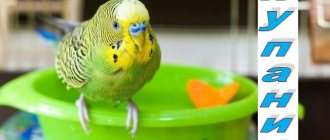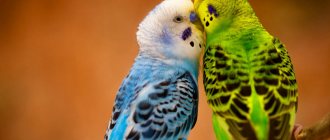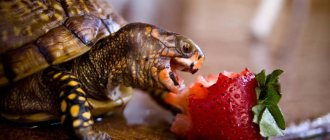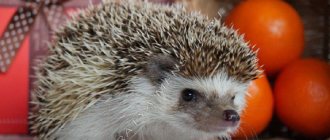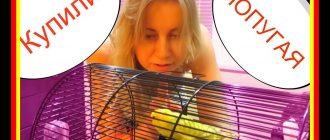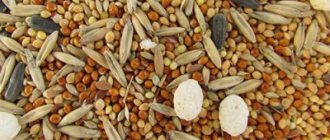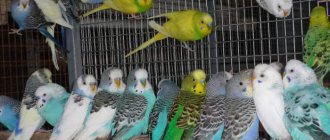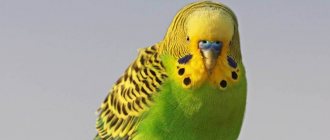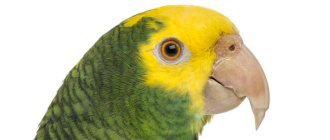Budgerigars are unpretentious pet birds that can brighten up an ordinary and boring environment. When keeping them, it is worth considering in detail - from the place of keeping to feeding. If you want your feathered pet to be able to delight you with its chirping and cooing for a long time, then it is better to create all the necessary conditions for its residence. For this reason, it is important to first consider how and what to feed your budgie correctly. The good health of the bird, as well as its beautiful appearance, will depend on this.
Grain mixtures
The diet of a budgerigar should include grain mixtures; they are an important component. At the same time, wavy fish require a variety of types of this food on the menu. These bird breeds have an enhanced metabolism, which is able to quickly digest grain feed.
The best option would be to have 6 different types of grains on the menu at once. Veterinarians do not advise experimenting with bird nutrition or creating a menu on your own. It is better to purchase ready-made food in specialized stores, which contains the necessary useful elements.
Your feathered pet’s daily menu should include the following grains:
- millet of various types - red, white, black, yellow. The component indicator should be 70% of the total volume;
- oats Its volume must be at least 10%;
- sunflower seeds, flaxseed, hemp and canary seed, wheat. The amount of grain crops should be 20%.
Many owners of feathered pets often have a question: is it possible to feed millet? Millet is a healthy product necessary for the proper development of poultry.
Millet cereals for feeding budgies must be selected carefully. A low-quality product can lead to poisoning and even death of the bird. The grain, suitable for feeding birds, has a large particle size, a uniform light yellow color and a slightly glossy surface. Cereals that are gray in color, covered with plaque and dust, of uneven size, with a musty odor, an admixture of dirt, signs of spoilage, affected by mold and pests are not suitable for feeding parrots. Millet is fed to parrots in 3 ways: in the form of dry cereal, in sprouted form and in the form of porridge.
What else can you feed your budgie at home besides grain food? Additionally, it can be mixed with boiled eggs, herbs, and fresh grass. They will saturate the food with vitamins and nutritional components.
You can read more about grain mixtures and food in the article “TOP 10 best food for budgies.”
Water as an essential component of nutrition
It participates in all life support processes and is part of the cells and tissues of organs. The need for water increases if the bird is fed exclusively with a grain mixture, and decreases somewhat when consuming succulent feed. A budgie needs more fluid when it has fever or diarrhea.
Not only the quantity of drink, but also its quality is of great importance. The liquid consumed by the bird should be at room temperature, fresh, clean, without harmful impurities. It is best to offer the wavy bottled water without carbon. The tap water needs to be filtered and allowed to brew. It is necessary to change it daily and at the same time thoroughly clean the drinkers.
Parrot nutrition part 10. Greens for the parrot. How to grow grass for a parrot at home
Fruits and vegetables
Complete and balanced feeding of budgies should include different types of fruits and vegetables. It is recommended to give them clean, so they should be washed in running water. They must be natural, without toxic chemicals.
Feed should be fresh vegetables and fruits. If they begin to rot or mold appears on their surface, then it is better not to give them to your feathered pets. They can negatively affect their health.
Among the vegetables on the menu, you can include varieties from the list:
- fodder type carrots. The vegetable is of high value. It contains a lot of carotene. It is given raw, grated or finely chopped. Additionally, it can be combined with a boiled egg or breadcrumbs;
- parrots love melon and pumpkin. They can also be given raw pumpkin seeds, but they should be ground;
- cucumbers Vegetables speed up your metabolism. They can be used as part of dietary nutrition when the feathered pet is overweight;
- tomatoes. Tomatoes contain acids and carotene. It is recommended to give budgies fully ripened tomatoes; unripe fruits contain a dangerous alkaloid element, which is dangerous not only for birds, but also for humans;
- fresh cabbage. The leaves can be torn into small pieces, and the stalk should be cut into small pieces with a knife;
- beet. The root vegetable contains sugar, fiber, vitamins, and microelements. The vegetable is simply necessary for birds. It can be stored for a long time;
- Birds are allowed green peas and beans. Legumes should be fresh, soft and young;
- Bell pepper. It has high levels of nutrients. It needs to be cut into small pieces along with the seeds.
In addition to the above vegetables, the menu should include fruits. They need to be given only fresh. They should not contain chemicals that can cause health problems for birds.
Among the fruits on the menu you can include the following types:
- Apples are valuable to parrots. They need to be given every day;
- pears are considered a tasty delicacy. But it doesn’t cost too much to give them;
- a sufficient number of oranges and tangerines. Citrus fruits have high levels of ascorbic acid (vitamin C), so they should definitely be given to birds;
- You can have bananas, but not a lot. They should not be given together with the skin;
- feathered pets will happily eat peaches and apricots;
- To boost the immune system, kiwi should be given periodically, but only without the skin.
You can read more about fruits and vegetables in the article “What fruits and vegetables can be given to budgies.”
Vegetable menu for parrots
Before offering vegetables to your budgie, they must be washed very thoroughly. If there is a suspicion that the nitrate content is too high, vegetables can be soaked in water for two hours - the nitrates dissolve and are mostly eliminated. Birds prefer vegetables to be grated or finely chopped.
The following crops are extremely contraindicated for budgies: eggplant; radish, daikon, radish; celery; garlic, onion.
All other vegetables for birds are considered healthy, but some nuances must be taken into account:
Beans, green peas, and corn can be offered to pets only in season and only in a slightly unripe form. If the beans are fully ripe, they accumulate substances that are difficult for birds to digest, which can only be removed through prolonged cooking. Green salad and spinach are fed in very moderate portions to avoid digestive upset. The tomato must be completely ripe. The green areas of the fruit must be cut out, since the alkaloid solanine it contains is harmful to birds. Under no circumstances should you offer your pet tomato leaves.
Chinese cabbage accumulates nitrates in its hard petioles, so it is advisable to feed birds only the green part of the leaf. White cabbage. There is still no clear answer to the question whether cabbage can be given to budgies. Some birds readily eat it without any side effects, and some experience indigestion. In any case, it is recommended to first rinse the cabbage leaf with boiling water. Carrots are considered the most valuable food. It is offered in grated form mixed with other ingredients, for example, a boiled egg. Cucumber is capable of accumulating nitrates, so it is better not to feed purchased products to the parrot.
The following types of vegetable crops will also be very useful for budgies: pumpkin, melon, watermelon, turnip, squash, zucchini, beets, bell pepper.
Greenery
To improve the nutrition of a budgerigar, it is recommended to use green food. It is one of the main components, because greens contain important beneficial substances that improve the health and strengthen the immune system of your feathered pet.
So what kind of grass and greens can be given to budgies? The birds' diet must include the following types of greens from the list:
- lettuce leaves;
- tops from beets, carrots;
- chicory salad;
- spinach;
- dandelion;
- clover;
- radish leaves;
- chickweed;
- plantain.
It is worth considering that there are forbidden greens that should not be included in the diet of birds:
- tops of potatoes, tomatoes, eggplants;
- all varieties of decorative flowers;
- laurel leaves;
- spurge;
- dill.
What should not be in the diet of birds: list of prohibited foods
You cannot mindlessly feed a bird food from the human table. It is contraindicated to give your feathered friend smoked, fried, canned or confectionery products, coffee, alcohol, chocolate, and mushrooms. Do not expose poultry food to microwave radiation, salt it, or add sugar to it. Before introducing a new food, you should always ask yourself: “Is there anything similar in the diet of wild parrots?” If you are not sure of this, it is better not to experiment with your pet’s health.
What should be in a parrot's diet
Twigs
Many bird owners, who are often interested in the question of how to properly feed a budgie, pay attention to the fact that their diet must include branches of various trees. Branch food has several advantages:
- parrots clean and sharpen their beaks on twigs;
- with its help, birds improve the condition of their claws;
- has a positive effect on health due to its fiber content and various microelements.
Preference should be given to twigs from maple, fruit trees, aspen, birch, and alder. Before giving them to your pet, they should be treated with hot water.
Does the choice of feeder affect your pet's appetite?
Some breeders believe that the decoration of the cage, including the type of feeder chosen for the pet, affects its appetite. It is not known whether this is really true, however, before purchasing a bird, it is important to decide on the appearance of the feeder that will be used. They come in several types:
- internal (usually sold immediately with the cage);
- external open;
- external closed;
- floor
The latter option is currently not popular among breeders, since birds leave a large amount of debris in the cage after feeding. It is better to give preference to metal products, since they can be processed without worrying that under the influence of high temperatures they will melt or become unusable. A feeder for budgies can also be made from scrap materials.
Porridge
When studying what budgies eat, it is worth taking into account porridges from various cereal crops. They quickly saturate the body and also fill it with useful substances.
Porridges and various cereals have some important features:
- they contain important microelements that normalize impaired metabolism;
- In order to make porridge, you can use buckwheat, beans, rice and others. They can be used together or separately;
- Additionally, you can add legumes, finely chopped vegetables, fruits;
- It is recommended to boil porridge only in water without adding salt and sugar;
- You can store them in the refrigerator, but no more than two days.
What grains are used for cooking
The most valuable porridges for a budgie are buckwheat, oatmeal, rice and pearl barley. Since millet is the basis of your feathered pet’s diet, boil it and gradually add other ingredients to the mixture. Millet should not exceed half of the total poultry diet.
1/4 Parrot menuPreparing for breeding. How to properly cook porridge for a parrot
List of allowed cereals:
- oatmeal;
- rice;
- buckwheat;
- wheat;
- corn;
- barley;
- pearl barley
Do not cook the porridge until fully cooked; it should be slightly damp. Oatmeal and buckwheat can be brought to a boil, then removed from heat, cover and leave for half an hour. It is also acceptable to steam cereals in a thermos. To do this, simply pour boiling water over them, cover and let sit for 6 hours.
Millet
This cereal does not require long cooking. Bring it to a boil, leave for 10-15 minutes and remove from heat. If you want to enrich millet with useful substances, add crushed boiled eggs or pieces of fruit.
porridge for parrots (basic)
Buckwheat
You can cook this porridge or steam it in a thermos. In the first case, fill it with water and keep it on the fire after boiling for 10 minutes. Then leave to simmer for half an hour. If you cook in a thermal mug, pour boiling water over the cereal and close the container with a lid. The dish will be ready in 6 hours.
Oatmeal
For oatmeal, buy regular cereal without additives and slow cooking. Fill them with water and cook for 10-15 minutes.
Jachka
Crushed cereals are useful for small chicks and parrots weakened by illness, as they are a good source of energy and are easier to digest in the gastrointestinal tract. Healthy parrots should be fed whole grains. Boil the cell for 10-15 minutes or steam in a thermos. You can mix it with grated raw carrots.
Porridge for parrots. Cooking porridge for Toshenka and Chika
Brown rice
Experienced breeders recommend using only wild and brown rice. The cereals are cooked for about 20-25 minutes, removed from the heat and simmered under the lid for half an hour.
Legumes – mung bean, peas, lentils
Soak the grains overnight and cook for 20-30 minutes in the morning. Cook red, green and pink lentils without soaking. Give green and brown ones in a soaked form.
Corn
This cereal takes a long time to prepare and requires pre-soaking for 6 hours. Cook for 20-25 minutes, serve warm.
Sprouted food
Sprouted food is nutritious, for this reason it can be used to replace grain mixtures. It contains a high level of fiber and beneficial vitamins. Due to the balanced composition, when consuming this food, the birds' immunity increases, their metabolism returns to normal, and malfunctions in the body are restored.
If you don’t know what you can feed your budgie, then sprouted food would be an excellent option. The main thing is to germinate the grains correctly:
- It is recommended to select grains for cooking;
- then washed under running water;
- the grains are filled with warm water and left overnight;
- then the grains are washed again, laid out on a saucer and covered with damp gauze, which is folded 3-4 times;
- The gauze needs to be moistened every 4 hours;
- after 24 hours the first shoots will appear;
The sprouted grains can be given to the parrot immediately. They can be stored for no more than 2 days.
Basic diet of budgerigars
It is known that the basis of a feathered pet’s diet is grain. However, it is important to diversify it with vegetables, fruits, and herbs. Do not forget that the “wavy”, like any other living creature, needs vitamins and minerals for normal life.
Grain feed
When purchasing a parrot, you should ask the breeder what kind of grain feed its parents ate. If the purchase was made at a pet store, it is enough to consult with a specialist to purchase a really good and nutritious product. It is important to consider that its main components may be:
When choosing a feed mixture, you should pay attention to its expiration date. If it has expired, the food will be of poor quality and may negatively affect the health of the bird.
Sprouted feed
It is a known fact that sprouted grains saturate the bird’s body with energy. They are enriched with vitamins, minerals, and fiber. It is important to enrich your bird’s diet with such food in winter. It is best to germinate grains of crops such as:
The shelf life of sprouted feed is only two days. Storage location: refrigerator. For this reason, you should not prepare large quantities of grains. For germination, you will need a shallow dish in which they will be placed, wrapped in gauze. In order for the grains to germinate, they must be constantly moistened.
Mineral supplements
It is imperative to feed your budgie with mineral supplements. Suitable ones include the following:
- chalk provides calcium replenishment. You can give it in a crushed state or in the form of pebbles. You need to use special chalk, most importantly not construction chalk;
- small eggshell. It has a lot of calcium, magnesium, iron, sulfur;
- bone flour. It contains a lot of phosphorus and calcium;
- The feathered menu needs to be supplemented with special vitamins and minerals, which are sold in the form of complexes in any pet store.
Drink
A budgerigar should always have clean water in its drinking bowl. It must be changed periodically, otherwise it will become dirty and simply unsuitable for drinking. But you need to know what kind of water to give your budgie.
It is not recommended to give boiled, raw water, or mineral water with gases to feathered pets. It must be filtered and purified. It should contain useful additives - potassium, magnesium, sodium. Additionally, you can add freshly squeezed juices, lemon juice, a decoction of chamomile, and rose hips to the water.
Daily diet
Having figured out what else budgerigars eat besides food at home, breeders are wondering how to organize feeding. It is known that the basis of the diet is grain feed. You need two teaspoons of them per day. Using only grain feed is harmful to your pet, and therefore half of the daily menu is taken up by greens, fruits and vegetables.
To properly feed your parrot, you should follow simple rules:
In addition, it is worth considering that if for some unknown reason the “wavy” refuses grain feed, it must be replaced with something else.
Can a budgerigar eat cheese, bread and other foods?
Additionally, food of animal origin can be included in the parrot's diet. But it is rarely required to be given, at least 2-3 times a month. But during the period of molting, nesting and for feeding the offspring, protein feed should be used more often - daily.
Protein foods include:
- cheese. It is worth using fermented milk with low fat content;
- chicken eggs. From time to time you can give your parrots a boiled egg;
- fish fat;
- cottage cheese. If you have a question: can budgies eat cottage cheese, then don’t worry, this component is allowed, but in limited quantities. It is worth using non-fat, up to 9% fat content.
It is not recommended to give budgies bread in large quantities. This is due to the fact that it contains the following components:
- yeast;
- salt, sugar;
- flour;
- sometimes there may be milk;
- can be made from rye flour.
It is best to dry bread crumbs and mix them with other types of food. They will go perfectly with the egg-carrot mixture. But at the same time, you should not abuse them; it will be enough to give them 2-3 times a month.
Feeding rules
The basis of the bird's diet is grain mixtures, which are poured into the feeder once a day. The daily norm is 2 teaspoons. It is important to change the food daily to prevent birds from eating feathers and excrement.
Using only grain food is harmful for the parrot, so during the day the pet should receive fruits, vegetables, herbs and porridge. The daily portion of complementary foods must be divided into several parts. The main thing is to monitor the quality of the food, and remove leftovers from previous feedings from the cage.
A budgerigar's diet should be varied, so several food options are placed in the cage at the same time. For example, the grain mixture is in the feeder, and pieces of fruit are in the rods.
Owners must understand that the bird is completely dependent on the person’s ability to take care of the pet. Therefore, you should approach feeding your parrot creatively.
Source
What not to feed budgies
When considering what to feed budgies, you should pay attention to prohibited foods, which under no circumstances should be included in the diet of your feathered pets. These include the following:
- salt. The bird’s body is simply not capable of processing this product on its own;
- spices, seasonings, herbs. They can provoke severe health complications in the bird, including its death;
- milk and derivatives. In order for this product to be properly absorbed, enzymes are required that are absent in the body of parrots. In addition, it has a high level of fat content;
- mushrooms. They can have a negative impact on the functioning of the digestive system;
- chocolate. It contains sugar and cocoa. These ingredients have a stimulating effect on the bird’s nervous system;
- You should not include certain types of vegetables in your diet - potatoes, radishes, eggplants, raw legumes.
What does a parrot eat?
The French amateur birder Jules Delon first spoke about the diet of budgerigars in his “Notes on Budgerigars” in 1845. Since then, many manuals and manuals have been published, but the basic rules of feeding have not changed - the birds' menu should be varied and contain all the necessary vitamins, microelements, proteins, fats, carbohydrates.
In the natural environment
Despite the fact that modern budgerigars are the fruit of long-term and painstaking selection, their food preferences have remained virtually unchanged. They prefer the same foods that their relatives eat in their homeland of Australia.
The main menu of wild parrots includes grains and seeds of various plants. During the period of abundance, birds peck at soft, milky-ripe seeds, but do not refuse hard, fully ripened grains.
When they succeed, they feast on fruits, berries, buds and young shoots, leaves of bushes and trees. During drought periods, the diet is supplemented with roots. Budgerigars eat insects and their larvae very rarely.
Important! Parrots love to feast on sweet palm sap. Hunters often use this. They hang cups of fermented drink on trees and wait for the birds that have flocked to the treat to become drunk and fall to the ground.
Fruits and berries
Food for budgies
However, let's move on to feeding parrots at home.
Store-bought feed
The food industry offers many varieties of ready-made dry food for birds. Parrots eat little; 1-2 tablespoons of grain mixture per day is enough for them. When purchasing, you should make sure of the quality of the food. A quality product contains:
- several types of grain - different varieties of millet (65-70%), oats (15-20%), sunflower seeds (10-15%), canary seed, wheat, hemp, flax;
- iodine;
- vitamin and mineral supplements.
In the rating of food for budgies, the first lines are occupied by:
- Italian food Fiory and Padovan.
- Blends from Germany Vitakraft and JR Farm.
- Belgian brand Prestige Versele-Laga.
- A line of mixtures for parrots from the Russian manufacturer RIO.
- Food from the Netherlands Witte Molen.
- Spanish food Cunipic.
Parrot food
Important! No matter how convenient ready-made mixtures are, they cannot fully satisfy all the needs of birds. In addition to them, the diet must contain soft and green food, fruit and vegetable supplements, sprouted grains, and animal feed.
Grain and porridge
The diet of budgerigars is based on mixtures of seeds of cultivated and wild plants:
- Various varieties of millet (seed, yellow, gray, silver, white, red, semolina, Japanese, Senegal) and its closest relatives (sorghum, barnyard grass, mogar, chumizu). More nutritious white and red millet are preferred for wavy millet, especially at the stage of milk maturity. If possible, the birds are fed with young panicles of the plant.
- Sunflower seeds are one of the favorite treats for parrots. However, due to the high content of oily substances, they should not be given too much. The best option is to add seeds to the grain mixture 1-2 times a week.
- Oats and oatmeal are an affordable dietary food for birds, containing vitamins B and E. They are especially necessary during the period of nesting and hatching chicks. The nutritional value of oatmeal depends on the percentage of films in the grain - the fewer there are, the more nutritious the food. It is useful to give the birds sprouted and steamed oats, and oatmeal will promote good digestion for the birds.
- Canary seed (canary seed). It is not grown in Russia and is often replaced with rapeseed and rape seeds (cultivated and wild). In terms of protein and carbohydrate content, it is slightly inferior to oatmeal, but superior to it in fat content.
- Wheat and barley are high-calorie foods. Before feeding, the grain is soaked for 10-12 hours, the water is drained, left wet for another 20-24 hours, washed under running water, and stored in the refrigerator for no longer than 3 days. They love feathered and sprouted barley and wheat grains.
- Large grains of corn are not very suitable for small birds, but parrots peck unripe milk cobs with pleasure.
- Hemp seed in large quantities causes obesity, eyelid swelling, and blindness. Despite the fact that parrots love it very much, they give no more than 10 seeds at a time.
- Flaxseed is given as a laxative in small quantities. The salad white seed serves as a delicacy. To prevent small seeds from “dissolving” in the main feed, they are poured in small quantities into separate bowls.
- Peas, beans, beans , rich in protein, are soaked in water and given to the birds. Birds benefit from green pods containing trace elements and vitamins. Edible crushed peas quickly turn sour when soaked; it is better not to use them.
- Buckwheat grains are given in unrefined form. They are soaked like wheat or fed sprouted, with a slightly sprouted white sprout.
- Rice is not very popular among poultry farmers. However, sprouted or soaked grains are a good nutritious feed with a low oil content.
- Poppy seed mixed with grated carrots serves as an excellent preventative against diarrhea.
- Weed seeds are given without restrictions. You can harvest the seeds of quinoa, dandelion, nettle, alfalfa, horse sorrel, clover, and Sudanese grass.
Poppy seeds
Important! Derivatives of grain feed (bran, crushed grain) are added to wet mash, for example, to a crushed boiled egg with carrots.
Porridges - buckwheat, rice, barley, pearl barley, millet, oatmeal - will be a good help in feeding budgies. Porridge can be cooked in water or milk, made crumbly, viscous, liquid, focusing on the individual tastes of the pet. The porridge is used immediately, without leaving it for storage.
Vegetables and fruits
Vegetables and fruits take second place in the diet of budgerigars. It is from them that birds receive most of their vitamins and microelements. Fruit and vegetable supplements are easier to digest than grains and have a beneficial effect on the functioning of the gastrointestinal tract. All vegetables and fruits are given raw, having first washed them thoroughly under running water, scalded with boiling water, cut into small pieces or grated on a coarse grater.
The parrot menu includes:
- Fully ripened cucumbers and tomatoes. Cucumbers contain iodine necessary for birds, and tomatoes contain carotene.
- Pumpkin, zucchini, squash. They will enrich the menu with pectin and fiber, B vitamins (1,2,5,6), A, C, E, K, PP, glucose, sucrose and fructose, and microelements (Ca, Fe, Mg, P, Zn). And pumpkin seeds will serve as a good anthelmintic.
- Turnip , which supplies birds with calcium and succinic acid.
- Bulgarian sweet and hot (rare) peppers of all colors along with seeds. It is a good supplier of B vitamins.
- White and red cabbage, kohlrabi, cauliflower, Chinese cabbage (tops of leaves only), broccoli, Savoy, Brussels sprouts, collards, Chinese and Japanese.
- Beets (table, fodder, sugar), rutabaga, containing a lot of fiber. Beets, like cabbage, are especially useful in winter, when there are no fresh seasonal vegetables and fruits.
- Carrots and vitamin A. Parrots like its mixtures with a boiled egg, other raw vegetables, mineral, vitamin and medicinal supplements, and breadcrumbs.
- Feathers of mild onion . In winter, you can plant onions on the windowsill.
- Salads and spinach. They are very useful, but in excessively large portions they can cause gastrointestinal upset. The leaves are slightly withered and dried, and then fed to the birds.
- Potatoes , raw and boiled, in small quantities. Do not give green tubers and tops that contain the toxic substance solanine.
- Non-acidic varieties of apples and pears , peeled and seeded. They are used fresh, dry and boiled. Dried fruits are soaked in water for 2-4 hours.
- Citrus fruits , peeled. They are fed slices. This is a very valuable product for parrots. It should be added to the menu regularly.
- Cultivated and wild berries - raspberries, black and red currants, cherries, cherries, grapes, strawberries, wild strawberries, sea buckthorn, cranberries, lingonberries, stoneberries, blueberries, cloudberries, rowan, viburnum, bird cherry. Served fresh and dried.
- Kiwi and ripe bananas, peeled and cut into pieces.
- Watermelon and melon. They have a weak diuretic and laxative effect.
- Grenades. But taking into account the fact that they are contraindicated for birds with liver diseases.
Watermelon slices
Important! The introduction of exotic fruits into the diet should be treated with caution. Some of them contain substances that are poisonous to budgies.
Plants
In addition to grains, seeds of fruits and vegetables, other types of food of plant origin are also useful for parrots:
- green mass of wild plants (dandelion, plantain);
- of shepherd's purse, dandelion;
- grass meal from nettle , alfalfa, clover, coniferous trees;
- branches of deciduous and coniferous (only in winter and early spring) trees.
Animal feed
Animal feed supplies birds with protein, an important building material for the body.
These include:
- Boiled chicken eggs. They are useful for adult birds and chicks. During the period of nesting and feeding the younger generation, eggs are given daily. In other periods regularly, but in small quantities. To the crushed and peeled eggs add grated carrots, bran, white crackers, semolina, vitamin and mineral preparations, flour (herbal, pine, bone, meat and bone, fish).
- Milk and dairy products (milk powder, low-fat cottage cheese, infant formula). Pressed and crumbly cottage cheese is given in pieces; soft cottage cheese is mixed with other ingredients, the same as for a boiled egg. Powdered milk and baby food are given in small doses - 1/3-1/2 teaspoon per 100 g of egg mixture.
- Insects and worms (mealworms, bloodworms, grasshoppers and grasshoppers, fruit flies, chafer larvae, small grasshoppers and grasshoppers, wax moths). In small doses, dry aquarium food (gommarus, daphnia) is added to the egg mixture.
- Boiled meat products , minced in a meat grinder in small doses (lean muscle meat, heart, kidneys, liver).
- Boiled fish , thoroughly pitted.
Budgerigar
Important! Egg shells are collected, dried and used as a mineral supplement. Another method can be used - boiled eggs in the shell are cut into pieces and placed in a feeder.
What do parrots like and what should you not feed them?
Your parrot's favorite food must be selected individually. Most birds love sunflower seeds, fruits and vegetables, egg mixture, and millet.
When compiling a diet, carefully study the list of foods that are dangerous and harmful to budgies. They are contraindicated:
- fruits (avocado, persimmon, papaya, mango);
- spicy herbs (parsley, cilantro);
- salt and sugar;
- alcohol;
- sausages, raw smoked products.
Many wild and indoor plants are especially dangerous. Their list includes more than a hundred items. Among them are acacia, anemone, arnica, anthurium, cloves, hyacinth, datura, buckthorn, cherry laurel, dieffenbachia, ivy, yew, juniper, spurge, foxglove, euphorbia, laurel, mistletoe, narcissus, foxglove, poinsettia, honeysuckle, and black elderberry.
Important! Many poultry farmers believe that small additions of white bread soaked in milk are beneficial. Opponents of baked goods point out that bread contains yeast, which upsets digestion.
What else can you give budgies?
Mine, I won’t give it to you!..
What can you feed parrots besides the above products? In minimal quantities, as encouragement and treats - nuts, acorns, chestnuts. For gourmets, you can buy special wooden sticks in stores, covered with a thin layer of honey or sugar syrup with seeds and grains glued to it.
Mineral and vitamin supplements are mandatory included in the menu:
- special mineral stones sold in pet stores;
- sepia (dried layer of cuttlefish shell);
- charcoal;
- organic sand, chalk, shell rock, corals;
- limestone, small pebbles;
- clay;
- multivitamin complexes.
Important! Mineral supplements are poured into a separate feeder and changed weekly. The expiration date of the stones is indicated in the attached instructions.
